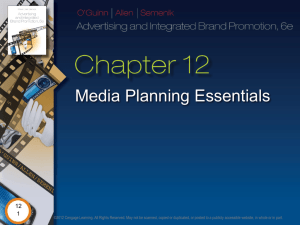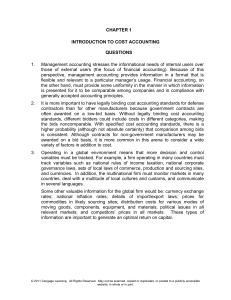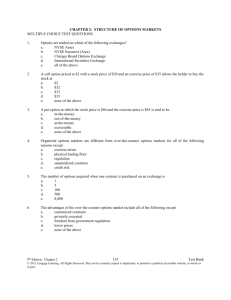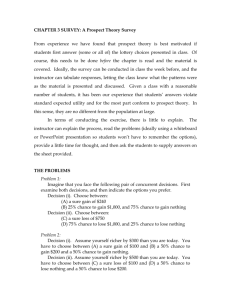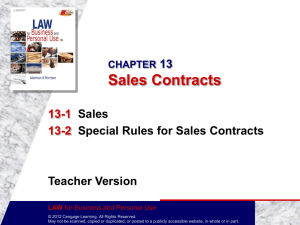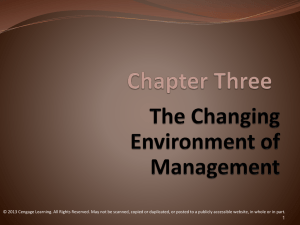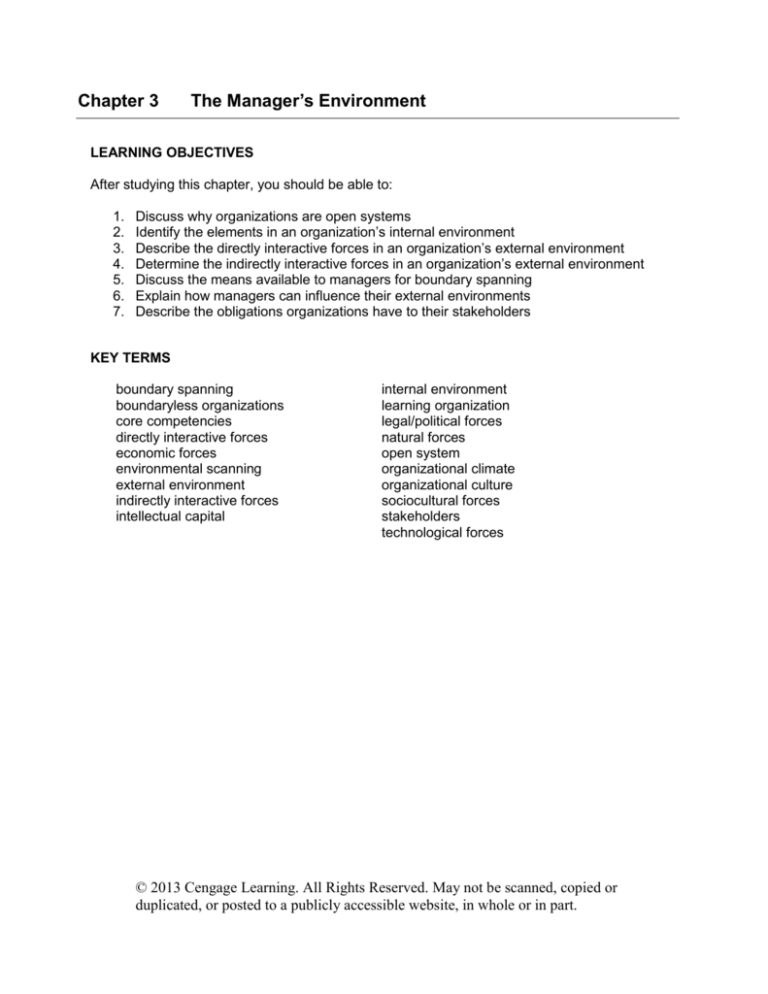
Chapter 3
The Manager’s Environment
LEARNING OBJECTIVES
After studying this chapter, you should be able to:
1.
2.
3.
4.
5.
6.
7.
Discuss why organizations are open systems
Identify the elements in an organization’s internal environment
Describe the directly interactive forces in an organization’s external environment
Determine the indirectly interactive forces in an organization’s external environment
Discuss the means available to managers for boundary spanning
Explain how managers can influence their external environments
Describe the obligations organizations have to their stakeholders
KEY TERMS
boundary spanning
boundaryless organizations
core competencies
directly interactive forces
economic forces
environmental scanning
external environment
indirectly interactive forces
intellectual capital
internal environment
learning organization
legal/political forces
natural forces
open system
organizational climate
organizational culture
sociocultural forces
stakeholders
technological forces
© 2013 Cengage Learning. All Rights Reserved. May not be scanned, copied or
duplicated, or posted to a publicly accessible website, in whole or in part.
CHAPTER OUTLINE
I. INTRODUCTION
II. THE ORGANIZATION AS A SYSTEM
III. INTERNAL ENVIRONMENT
A. Core Competencies
B. Organizational Culture
C. Organizational Climate
D. Leadership
E. Organizational Structure
F. Resources
1. Information
2. Facilities and Infrastructure
3. Machinery and Equipment
4. Materials and Supplies
5. Finances
IV. EXTERNAL ENVIRONMENT
A. Directly Interactive Forces
1. Owners
2. Customers
3. Suppliers and Partners
4. Competitors
5. Labor Force
B. Indirectly Interactive Forces
1. Economic Forces
2. Legal/Political Forces
3. Sociocultural Forces
4. Technological Forces
5. Natural Forces
C. ENVIRONMENTS AND MANAGEMENT
V. Sensing and Adapting to Environments
VI. Influencing Environments
VII. Meeting Responsibilities to Stakeholders
A. Owners
B. Employees
C. Customers
D. Suppliers
E. Society
Enrichment Vignette
Do you watch things happen or do you make things happen? Some managers focus on
coordinating and resolving conflicts between internal and external forces and in achieving
consensus among the various stakeholders—in essence, they are reactive, not proactive. They
may be one step up from simply watching things happen, but they do not really make things
happen. Henry Ford was a person who made things happen—and it went beyond being one of
the pioneers of the automobile and the assembly line. He did not simply try to balance internal
and external forces and seek to keep all stakeholders happy—though many critics even today
© 2013 Cengage Learning. All Rights Reserved. May not be scanned, copied or
duplicated, or posted to a publicly accessible website, in whole or in part.
can list problems because of that characteristic. He did make things happen, although not all
that he did may have been a good idea. His “make things happen” orientation is illustrated by a
story that has been passed on (and probably distorted far from whatever truth may have been in
the original version) about an instance in which he was considering a major change. He brought
his experts together and explained what he was planning to do. The experts gave him all the
reasons why it could not be done. He then fired those people and hired people who were too
ignorant to realize that it could not be done, and so they went ahead and did it. Or so the story
goes!!
LECTURE OUTLINE
The outline below (the lecture outline) is referenced to the above chapter outline and contains
supplementary material to enhance your discussion of the chapter, but it is organized somewhat
differently. As a result, you have a choice: by using what is in the outline below, (1) you may
present the above chapter outline material in a different sequence, or (2) you may use the
chapter outline references in the outline below to present the lecture outline material in the
same sequence as the chapter outline.
I.
INTRODUCTION (CHAPTER OUTLINE: SECTION I)
II.
THE ORGANIZATION AS A SYSTEM (CHAPTER OUTLINE: SECTION II)
A.
Closed and Open Systems
1.
2.
3.
4.
5.
B.
Closed systems were independent of outside influences. (A “thing” of the past.)
Closed systems were characterized by classical management theories.
Organizations are operating systems of interrelated variables.
Currently, experts believe all ongoing successful organizations are open with
interactive forces, i.e., few, if any, closed systems exist today.
Direct and indirect interactive forces impact upon open systems.
Managers’ Environments
1. Managers must operate within both internal and external elements.
2. Internal elements comprise the organization itself.
All other factors outside of an organizational structure comprise the totality of external
environments.
Environmental scanning is a process of collecting information about the external
environment in order to identify and analyze trends.
III.
INTERNAL ENVIRONMENT (CHAPTER OUTLINE: SECTION III)
A. Core Competencies
What are the organization’s distinctive capabilities?
B.
Organizational Culture
1.
An organization’s culture is a dynamic system of shared values, beliefs,
philosophies, experiences, customs, and norms of behavior.
© 2013 Cengage Learning. All Rights Reserved. May not be scanned, copied or
duplicated, or posted to a publicly accessible website, in whole or in part.
2.
3.
4.
C.
Organizational Climate
1.
2.
D.
2.
The amount of involvement of others within a problem-solving or decision-making
process reflects the style of leadership of an organization.
Active participation of subordinates and teamwork are an indication of
contemporary management thinking.
Organizational Structure
1.
2.
3.
4.
5.
F.
1.
2.
IV.
An outgrowth of a corporation’s culture is its organizational climate, which shows
how employees feel about working at the particular firm.
Successful organizations have open climates where employees are empowered
to perform many tasks.
Leadership
1.
E.
Top management provides a primary framework for an organization’s culture.
Employees determine and shape the culture through a continuous process of
formal and social interacting subsystems.
Corporate culture is to an organization as a personality is to an individual.
Activities are conducted throughout an organization dependent upon the
structural layout of organizational design.
Authority is a part of the tiers of management from upper to lower management.
Boundaryless organizations are not defined or limited by horizontal, vertical, or
external boundaries imposed by a predetermined structure. They are relatively
flat and focus on teams.
Learning organizations is one that is able to adapt and respond to change.
A boundaryless environment is required by learning organizations to facilitate
team collaboration and the sharing of information.
Resources
People are the paramount resource of all organizations.
Information, facilities, machinery, equipment, materials, supplies, and finances
are supporting, non-human resources that complement workers in their quest to
accomplish the mission.
a. Information
b. Facilities and Infrastructure
c. Machinery and Equipment
d. Materials and Supplies
e. Finances
EXTERNAL ENVIRONMENT (CHAPTER OUTLINE: SECTION IV)
A.
Directly Interactive Forces
1.
2.
The immediate effect of interacting environmental forces comes from direct
association with various elements.
Owners, customers, suppliers, partners, competitors, and the labor force
© 2013 Cengage Learning. All Rights Reserved. May not be scanned, copied or
duplicated, or posted to a publicly accessible website, in whole or in part.
comprise the primary elements of direct impact or interactive forces.
B.
Indirectly Interactive Forces
1.
2.
C.
V.
Although somewhat physically removed, indirect forces still remain an interactive
element of impact for many organizations.
All elements of indirectly interactive forces are indicated in the chapter.
a. Economic Forces
1. Conditions in an economy that influence management decisions and
the costs and availability of resources.
b. Legal/Political Forces
1. General framework of statutes enacted by legislatures; precedents
established by court decisions; regulations and rulings created by
various federal, state, and local regulatory agencies; and agreements
between and among governments and companies from different
nations.
c. Sociocultural
d. Technological
e. Natural Forces
ENVIRONMENTS AND MANAGEMENT
Sensing and Adapting to Environments (CHAPTER OUTLINE: SECTION V)
A. Being aware, staying in touch, and acutely observing the conditions of all
environments are critical to becoming successful managers. This surveillance of
outside areas is called boundary spanning.
B. The reflections of the past, the awareness of the present, and the foresight of the
future allow management and organizations to cope, survive, and grow within an everchanging economy.
VI.
Influencing Environments (CHAPTER OUTLINE: SECTION VI)
1.
2.
3.
Management and organizational decision making impact greatly upon society.
Power and influence affect public policy and opinions.
Actions, no actions, and reactions by managers can cause changes within
society. Managers must keep this social responsibility in mind and in control.
VII. Meeting Responsibilities to Stakeholders (CHAPTER OUTLINE: SECTION V!!)
1.
2.
3.
4.
Stakeholders are the groups that are directly or indirectly affected by the ways in
which business is conducted and managers conduct themselves.
Stakeholders are dependent upon organizational policy and practice.
All stakeholder groups gain or lose depending upon how businesses operate.
Owners, employees, customers, suppliers, and society in general constitute
types of stakeholders.
SUGGESTED RESPONSES TO REVIEW QUESTIONS
© 2013 Cengage Learning. All Rights Reserved. May not be scanned, copied or
duplicated, or posted to a publicly accessible website, in whole or in part.
In what ways does your school or place of employment demonstrate the fact that it is
an open system?
1.
Answers will naturally vary among students. However, the instructor can solicit
participation from several students to allow them to compare and contrast their
comments. Students should focus on elements of employee involvement and
empowerment in their discussions on open systems.
2.
What are the elements in an organization’s internal environment?
Within an organization’s boundaries, the mission, leadership style, management
philosophy, formal structure, climate, and available resources all interact and impact
upon each other. The totality of exchange of all internal elements identifies the
corporate culture, which in turn sets the daily tone of the corporate climate.
3.
What is a boundaryless organization?
Boundaryless organizations are not defined or limited by horizontal, vertical, or
external boundaries imposed by a predetermined structure. They are relatively flat
and focus on teams.
4.
How does a learning organization empower employees?
Learning organizations are able to adapt and respond to change. A boundaryless
environment is required by learning organizations to facilitate team collaboration and
the sharing of information. When an organization develops the continuous capacity to
adapt and survive in an increasingly competitive environment because all members
take an active role in identifying and resolving work-related issues, it has developed a
learning culture. This design empowers employees because they acquire and share
knowledge and apply this learning to decision-making.
5.
Which forces in an organization’s external environments are task or directly
interactive? Why are they so?
Owners, customers, suppliers, partners, competitors, and the labor force belong to
the external environment. All of these forces directly interact because of the
immediate proximity to the organization. These forces are not an internal part of the
organization; however, they are influential fringe elements to the organization’s
existence.
6.
Which forces in an organization’s external environments are general or indirectly
interactive? Why are they so?
At the “outer” limit of organizational environments are the indirectly interactive forces.
The forces are physically removed, yet still important to, the interactive nature of
organizational existence. These factors include technological advances, economic
conditions, natural resources, legal and political climates, international influence, and
sociocultural issues.
© 2013 Cengage Learning. All Rights Reserved. May not be scanned, copied or
duplicated, or posted to a publicly accessible website, in whole or in part.
7.
How can managers stay in touch with their external environments?
As an analogy, managers must be able to stand inside the business “forest” or
environment and be able to see and count the trees. They must also be able to see
beyond the immediacy of their world. An understanding, awareness, and knowledge
of factors outside the daily contacts and environment is paramount to staying in touch
with the “big picture” of external issues, i.e., look beyond the trees.
8.
What can managers and their organizations do to influence their external
environments?
Managers and organizations create, cause, impact, and affect the daily welfare and
well-being of others. Individuals as well as society in general are influenced by the
daily decisions of businesses. Managers must be aware of the power that they hold
which can hinder, help, or change the conditions of others.
9.
What groups compose an organization’s stakeholders? What obligations does an
organization have to each group?
Businesses are totally responsible and obligated to various constituents. These
constituent groups are the stakeholders that are directly and indirectly associated with
the conduct of organizations. These groups include owners, employees, customers,
suppliers, and society in general. Businesses must respond to their needs.
10. Discuss the importance of customer satisfaction to quality.
Quality is an important component to customer satisfaction. Proper design, safety
features, product warranties and guarantees all add to the value of the product.
Quality is what sets products apart from the competition. Customer satisfaction and
loyalty is achieved when companies manufacture and sell exceptional products.
INSTRUCTIONAL EXPLANATION: DISCUSSION QUESTIONS FOR CRITICAL THINKING
These thought-provoking questions are provided by the authors for each chapter as primers for
student discussion. This method of questioning ensures that the students have read the
assigned materials or content. These questions are presented to generate thinking and
discussion. They can be used as supplemental homework assignments and/or class
discussions that center around specific critical thinking issues and applications.
It is important that students are able to respond from their experiences and through their
perceptions as well as incorporate the specific course content into their reasoning, explanations,
descriptions, and individualized contributions. Most of these questions cannot be answered in a
right/wrong fashion.
Instead, student responses and/or group discussions should be
encouraged by the instructor to bring out individualized critical thinking as opposed to absolute
correct answers.
WEB 2.0 EXERCISES
Competitive Intelligence, Social Media, and Chief Listening Officer
© 2013 Cengage Learning. All Rights Reserved. May not be scanned, copied or
duplicated, or posted to a publicly accessible website, in whole or in part.
The term Social Media refers to the use of web-based and mobile technologies to turn
communication into an interactive dialogue. Andreas Kaplan and Michael Haenlein define social
media as "a group of Internet-based applications that build on the ideological and technological
foundations of Web 2.0 and that allow the creation and exchange of user generated content.”
Social media is media for social interaction as a superset beyond social communication. Enabled
by ubiquitously accessible and scalable communication techniques, social media has
substantially changed the way organizations, communities, and individuals communicate.
1. In his blog, Glenn Gow discusses pairing CI with social media to broaden the scope
of the CI function.
Read “Is social media missing from your competitive intelligence?”
How does pairing CI with social media differ from knowing about how competitors
use social media?
Discuss three ways a company could monitor social media to enhance its
competitive intelligence capabilities.
2. Do you think companies need a Chief Listening Officer to monitor social media?
Explain.
The student answers to these questions will vary greatly. Similar to the critical thinking
questions provided throughout the text, these questions allow students the opportunity to think
in a broad, creative sense with many variables or choices for response. It is important that the
instructor encourage the students to “back up” or support their answers with specific subject
content from the text as well as provide a rational/logical approach to their comments.
SUGGESTED RESPONSES TO EXPERIENTIAL LEARNING CASE: BARNES & NOBLE
REFOCUSES
1.
To which environmental forces is Barnes & Noble responding?
There are several forces that Barnes & Noble is responding to in its strategic decision to
offer products via Internet. Customers are demanding convenience and flexibility in their
shopping ventures. By offering products via the Internet, Toys ‘R’ Us is satisfying customer
needs and expectations. However, the major force that Toys ‘R’ Us addresses in its
Internet quest is the technological environment. The firm has assessed the impact of this
force and knows that it must respond to the need to expand its boundaries through
advances in technology.
2.
What is appealing to customers about ordering online?
Customers who order online can enjoy the benefits of convenience and flexibility, product
variety, timely delivery, product availability, as well as other advantages of engaging in e-
© 2013 Cengage Learning. All Rights Reserved. May not be scanned, copied or
duplicated, or posted to a publicly accessible website, in whole or in part.
commerce.
3.
What are the advantages to a firm of selling online?
A firm that sells its products online actually creates a boundaryless organization. It
enlarges its markets and is able to reach customers it would have not been able to reach
otherwise without incurring astronomical costs. A firm can mass market and distribute its
product, thereby reducing overhead and increasing delivery times because it has direct
linkages with manufacturers.
ON THE JOB VIDEO CASE SOLUTIONS
Video: Preserve by Recycline: Environment & Corporate Culture
Discussion Questions and Suggested Answers:
1.
In view of the fact that the firm’s internal culture is exactly what the founder desired
and is nurtured by his key people, do you think that the firm has been successful due
to that culture or in spite of it? Why? Could a firm that had a formal dress code, for
example, have been just as creative?
2.
In evaluating the firm’s creativity, adaptability, and speed in decision-making, what is
most important? Is it internal culture or is it the small size of the organization? Explain.
3.
Who are the firm’s stakeholders? Who is the most important? Why?
Student’s answers may vary. The answers should demonstrate a strong knowledge of the
chapters’ main objectives as they apply to Recycline. Class discussion may be helpful in
eliciting creative responses.
TEAM ACTIVITY
The team members will play the role of consultants who must make recommendations to the
leadership of their educational institution. They must take each of the chapter’s learning
objectives and show how it could be applied to either strengthen or make changes to the
institution. This includes identification of the institution’s stakeholders, its internal and external
environmental forces, etc.
BIZ FLIX VIDEO CASE
Video Case: Charlie Wilson’s War
Video Case Synopsis
© 2013 Cengage Learning. All Rights Reserved. May not be scanned, copied or
duplicated, or posted to a publicly accessible website, in whole or in part.
Democratic Congressman Charlie Wilson (Tom Hanks) from East Texas lives a reckless life that
includes heavy drinking and chasing attractive women. The film focuses on Wilson’s
involvement in the Afghanistan rebellion against the Soviet troop invasion in the 1980s. Wilson
becomes the unlikely champion of the Afghan cause through his role in two major congressional
committees that deal with foreign policy and covert operations. Houston socialite Joanne
Herring (Julia Roberts) strongly urges the intervention. CIA agent Gust Avrakotos (Philip
Seymour Hoffman) helps with some details.
This sequence appears early in the film after a scene showing the characters drinking
and partying in a hot tub. It opens with a shot of the Capitol Building. Congressman Charlie
Wilson talks to his assistant Bonnie (Amy Adams) while walking to chambers for a vote. The
sequence ends after Wilson enters the chambers.
Video Case Discussion Questions and Suggested Answers
1. Of the various types of indirectly interactive forces at work in this situation, which is most
prominent in this video?
The film deals primarily with the political-legal force, as opposed to the sociocultural,
economic, natural, or technological forces. You may want to extend the discussion to
address how both politics and the law hold a great deal of influence over the way business
is conducted, and that many of the issues of concern to business managers will be
identified, evaluated, and possibly resolved through political and legal channels.
2. Who are the stakeholders for a congressional representative like Wilson?
Students should be able to recognize that a congressional representative represents the
people of his or her state or district, who could be described as “customers.” However, in a
democracy, politicians should also serve the greater good of the country and the world, so
“society” at large is also a stakeholder. Congressional representatives also have staffs, so
“employees” are another type of stakeholder.
3. At one point in the film clip, Wilson says he is “on the other side” of ethics. What does he
mean by this? Discuss the significance of this statement.
Wilson is clearly surprised that he is being assigned to the ethics committee. From this, we
can surmise that he is not known for ethical conduct, and is perhaps even somewhat proud
of his “bad boy” reputation. Students will have differing opinions about whether this is
acceptable in a politician, which can extend to their attitudes toward the value and
importance of ethical conduct among businesspeople.
© 2013 Cengage Learning. All Rights Reserved. May not be scanned, copied or
duplicated, or posted to a publicly accessible website, in whole or in part.







